The Use of Activities and Resources in Archaeological Museums for the Teaching of History in Formal Education
Abstract
1. Introduction
1.1. The Approach of Classroom Museums and Museums for the Classroom
1.2. Museums as a Means of Education
“Understanding our past, knowing how past civilizations lived, discovering what they ate and how they interacted are common interests for people. Indeed, history, and, therefore, archaeology, generates curiosity. But in order to understand the past in all its complexity we need educational tools which bring us closer to it”[14] (p. 320).
1.3. International Research Regarding the Use of Resources and Activities Based on Museum Visits
Despite their young age, in the museum tour, children were restricted to moving between dioramas and just looking at the exhibits. In Versions 1 and 2 a variety of other actions enriched the children’s visit and increased opportunities for movement. The simple viewing of the museum dioramas was reduced, and the handling of objects was introduced and then increased. Children were invited to look at a variety of resources and work together in groups[15] (p. 13).
1.3.1. Type of Activities
“observing an object or phenomenon; generating questions, brainstorming and exploration; gathering data, synthesizing findings by creating an exhibit, object, and research papers; disseminating key learnings outside of the classroom through school exhibit openings; presentations, and demonstrations; and reflection” (p. 3).
1.3.2. Use of Materials and Resources
“These types of resources do not truly create an atmosphere of dialogue between the museum and its users (…) the most important thing for a museum to make itself suitable to this type of audience is the predisposition of the museum to interact with them, to transform itself from a passive exhibition into an active laboratory”[36] (p. 36).
2. Materials and Methods
2.1. Defining the Hypotheses
2.2. Approach and Design
2.3. Context and Participants
2.3.1. The Archaeological Museum Located in Murcia (MU)
2.3.2. The Archaeological Museum Located in Alicante (MA)
2.3.3. Participants in the Research
2.4. Survey Structure
2.5. Procedure for the Collection, Handling and Analysis of the Data
3. Results
3.1. Design and Development of Activities
3.1.1. Results as Far as the Role of the Educational Agents Is Concerned
- (a)
- Development of activities from the point of view of the teachers:
- (b)
- Development of pre-visit activities and types of activities carried out beforehand within the design of the field trip according to the teachers:
- (c)
- Development of post-visit activities and those types of activities which are carried out subsequently within the design of the field trip according to the teachers:
- (d)
- Development of activities from the point of view of the museum educators:
3.1.2. Results Regarding the Educational Space
- (a)
- Results from the teachers’ point of view:
- (b)
- Results from the point of view of the educators
3.1.3. Results According to Educational Level
3.2. Use of Materials and Resources
- Web pages, audio-visual videos, photographs or any ICT resources which do not imply the direct participation of the user. These are the educational resources employed, which, according to Cuenca, Molina and Martín, used for communication in the heritage context, fit into the classification of ‘Passive ICT resources’ [47].
- Videogames, web applications, QR codes, augmented reality, virtual museums or any ICT tools which do foster the active involvement of the user. These resources, within the classification established for the communication of heritage, are known as ‘Active ICT resources’ [47].
- Books, interviews, people from the immediate environment, etc., materials which act as sources of information, be it textual, oral, etc.
- Worksheets or edited bibliographic material.
- Objects or material remains which hold relevant historical information susceptible to analysis and study.
- Models or reproductions.
- Cartographic representations, maps.
3.2.1. Results Regarding the Role of the Educational Agents
- (a)
- Use of resources from the teachers’ point of view
- (b)
- Use of resources from the point of view of the museum educators:
3.2.2. Results Relating to the Educational Museological Space
- (a)
- Results from the teachers’ point of view:
- (b)
- Results from the museum educators’ point of view:
3.2.3. Results According to Educational Level
4. Discussion and Conclusions
- -
- The educators prepare activities prior to the visit with the teachers or continue in contact with the schools for later work on occasions. Eight out of ten educators consider that they never or occasionally prepare previous activities or carry out a follow-up that guarantees subsequent activities are fulfilled, while two out of ten estimates that they do so very frequently or with some frequency.
- -
- The teacher carries out pre-visit activities with some or a great deal of frequency, while post-visit activities are carried out very frequently.
- -
- The frequency with which subsequent activities are carried out is slightly higher than that of previous activities. 59% of the teachers always or very frequently carry out pre-visit activities, while 71.4% of the teachers plan post-visit activities.
- -
- According to educators, teachers frequently demand resources, which the museum offers very frequently. A total of 81.3% of educators believe that teachers demand resources frequently or sporadically. A total of 56.3% of educators believe that they always or very often offer resources to schools and 43.7% of teachers believe that they frequently or occasionally offer resources to schools.
- -
- The teachers consider that they demand resources from the museum and the museum offers resources only sporadically/rarely. A total of 58.4% of teachers consider that they never or occasionally demand resources from the museum. A total of 52.7% of the teachers are of the opinion that the museum never or sporadically offers resources and 47.3% quite frequently, very frequently or always.
- -
- The frequency with which resources and materials are offered and demanded at the Alicante Museum (AM) is higher than at the Murcia Museum (MM).
- -
- When the visit is organized through the museum’s booking system, the frequency with which the museum offers resources to the school increases. This frequency is even higher at the AM.
5. Study Limitations
- -
- To analyze the educational practices carried out in these non-formal educational contexts.
- -
- To triangulate the results with mixed designs incorporating the point of view of the educational agents, by way of qualitative techniques such as in-depth interviews, group discussions and participant observation.
- -
- To verify whether the post-visit activities which the teachers claim to carry out are indeed put into practice and what their teaching methodology consists of (contents, assessment indicators, standards, competences, methodology, assessment, organization of spaces, times, etc.).
- -
- To understand the perspective of the pupils regarding the conception they hold of museums, school visits to museums, and the development of the activities around the field trip to the archaeological museum.
- -
- To compare the teachers’ and educators’ perspectives with those of the pupils.
- -
- To enrich the results of this research with other advanced multivariate analyses, such as regression analysis and confirmatory factor analysis, among others.
- -
- Better training of museum educators and teachers so that they are able to understand their legal and curricular responsibilities, are aware of the teaching potentials of a museum visit (purposes, use of resources and activities, etc.) and learn how to use the visit to the archaeological museum as a field trip to work on history.
- -
- To design strategies that facilitate collaboration between the museum and the school in preparation for the school visit to the museum or to use this space as a learning resource in the classroom.
- -
- To encourage the utilities and tools necessary to use museum visits as an experimental outing.
- -
- To establish beforehand, a plan of what should be learned from the visit, how that learning is to be achieved and what tasks each of the agents involved in the visit are to carry out.
- -
- To facilitate the planning of the school visit to the museum by the educational community.
- -
- To guarantee that the activities before and after the school visit are carried out and that the archaeological museum somehow participates in the monitoring of these activities.
- -
- To integrate the school visit to the archaeological museum as a learning content or resource within a didactic or teaching unit or within a learning project (learning based on problems, service learning, etc.).
- -
- To encourage the use of ICT resources that allow students to participate and interact with heritage elements.
- -
- To draw up an intervention program that favors and provides resources and support for promoting strategies aimed at the design of collaborative learning projects between museums and schools.
Author Contributions
Funding
Institutional Review Board Statement
Informed Consent Statement
Acknowledgments
Conflicts of Interest
Appendix A. The Questionnaire MUSELA DO
| Type of Activity | Museum | Classroom | Before | During | After |
| Experimentation or artistic workshop | ☐ | ☐ | ☐ | ☐ | ☐ |
| Role Play or theatrical representation | ☐ | ☐ | ☐ | ☐ | ☐ |
| Problem-solving cooperative tastks | ☐ | ☐ | ☐ | ☐ | ☐ |
| Treasure hunts | ☐ | ☐ | ☐ | ☐ | ☐ |
| Debate, brainstormings, round table discussions | ☐ | ☐ | ☐ | ☐ | ☐ |
| Observation tasks and/or handling of objects | ☐ | ☐ | ☐ | ☐ | ☐ |
| Fieldwork | ☐ | ☐ | ☐ | ☐ | ☐ |
| Data representation | ☐ | ☐ | ☐ | ☐ | ☐ |
| Interviews of experts or family members | ☐ | ☐ | ☐ | ☐ | ☐ |
| Viewing of audio-visual materials | ☐ | ☐ | ☐ | ☐ | ☐ |
| Creation of a classroom museums or exhibition of objects | ☐ | ☐ | ☐ | ☐ | ☐ |
| Others: _______________________________________. | ☐ | ☐ | ☐ | ☐ | ☐ |
| Type of Resources | Museum | Classroom | Before | During | After |
| Web pages, audiovisual videos, photographs | ☐ | ☐ | ☐ | ☐ | ☐ |
| Video games, apps, QR codes, augmented reality, virtual museum | ☐ | ☐ | ☐ | ☐ | ☐ |
| Books, interviews, people from the immediate environment | ☐ | ☐ | ☐ | ☐ | ☐ |
| Worksheets | ☐ | ☐ | ☐ | ☐ | ☐ |
| Objects and material remains | ☐ | ☐ | ☐ | ☐ | ☐ |
| Models or reproductions | ☐ | ☐ | ☐ | ☐ | ☐ |
| Cartographic representations, maps | ☐ | ☐ | ☐ | ☐ | ☐ |
| Other:___________________________________________________. | ☐ | ☐ | ☐ | ☐ | ☐ |
Appendix B. The Questionnaire MUSELA EDU
| Type of Activity | 1. Never | 2. Punctually/Rarely | 3. With Some Frequency | 4. Very Often | 5. Always |
| Experimentation or artistic workshop | ☐ | ☐ | ☐ | ☐ | ☐ |
| Role Play or theatrical representation | ☐ | ☐ | ☐ | ☐ | ☐ |
| Problem-solving cooperative tastks | ☐ | ☐ | ☐ | ☐ | ☐ |
| Treasure hunts | ☐ | ☐ | ☐ | ☐ | ☐ |
| Debate, brainstormings, round table discussions | ☐ | ☐ | ☐ | ☐ | ☐ |
| Observation tasks and/or handling of objects | ☐ | ☐ | ☐ | ☐ | ☐ |
| Fieldwork | ☐ | ☐ | ☐ | ☐ | ☐ |
| Interviews of experts or family members | ☐ | ☐ | ☐ | ☐ | ☐ |
| Viewing of audio-visual materials | ☐ | ☐ | ☐ | ☐ | ☐ |
| Others: _______________________________________. | ☐ | ☐ | ☐ | ☐ | ☐ |
| Type of Resources | 1. Never | 2. Punctually/Rarely | 3. With Some Frequency | 4. Very Often | 5. Always |
| Web pages, audiovisual videos, photographs | ☐ | ☐ | ☐ | ☐ | ☐ |
| Video games, apps, QR codes, augmented reality, virtual museum | ☐ | ☐ | ☐ | ☐ | ☐ |
| Books, interviews, people from the immediate environment ... | ☐ | ☐ | ☐ | ☐ | ☐ |
| Worksheets | ☐ | ☐ | ☐ | ☐ | ☐ |
| Objects and material remains | ☐ | ☐ | ☐ | ☐ | ☐ |
| Models or reproductions | ☐ | ☐ | ☐ | ☐ | ☐ |
| Cartographic representations, maps | ☐ | ☐ | ☐ | ☐ | ☐ |
| Others: ____________________________________________. | ☐ | ☐ | ☐ | ☐ | ☐ |
References
- International Council of Museum (ICOM). Resolutions Adopted by ICOM’s 34th General Assembly; Internatinal Council of Museum: Kyoto, Japan, 2019; Available online: https://icom.museum/wp-content/uploads/2019/09/Resolutions_2019_EN.pdf (accessed on 12 January 2021).
- Rivero, P.; Navarro-Neri, I.; García-Ceballos, S.; Aso, B. Spanish Archaeological Museums during COVID-19. An Edu-Communicative Analysis of Their Activity on Twitter through the Sustainable Development Goals. Sustainability 2020, 12, 8224. [Google Scholar] [CrossRef]
- Modzelewska, A.; Skuza, S.; Szeluga-Romańska, M.; Materska-Samek, M. Towards Greater Citizen Participation in Financing Public Cultural Institutions—Legal Barriers and Proposed Solutions. Sustainability 2020, 12, 7957. [Google Scholar] [CrossRef]
- Department for Education and Skills. Learning Outside the Classroom MANIFESTO; DfES Publications: Nottingham, UK, 2006.
- Boto-Álvarez, A.; García-Fernández, R. Implementation of the 2030 Agenda Sustainable Development Goals in Spain. Sustainability 2020, 12, 2546. [Google Scholar] [CrossRef]
- Jiménez, G.; Plaza, A.; Echeverría, P. Museos temáticos como recurso didáctico para la enseñanza y aprendizaje de las ciencias sociales. CONRADO. Rev. Pedagóg. Univ. Cienfuegos 2019, 15, 116–122. [Google Scholar]
- Cuenca, J.M.; Estepa, J.; Martín, M. Patrimonio, educación, identidad y ciudadanía. Profesorado y libros de texto en la enseñanza obligatoria. Rev. Educ. 2017, 375, 136–159. [Google Scholar] [CrossRef]
- Department of Economic and Social Affairs, Sustainable Development of ONU. Transforming Our World: The 2030 Agenda for Sustainable; United Nations Organization: New York, NY, USA; Available online: https://sdgs.un.org/2030agenda (accessed on 25 January 2021).
- Escribano-Miralles, A. El museo de aula para el tratamiento globalizado de la historia en educación infantil. In Estrategias y Recursos Para la Integración del Patrimonio y Los Museos en la Educación Formal; Arias, L., Ponce, A.I., Verdú, D., Eds.; EDITUM, Servicio de Publicaciones de la Universidad de Murcia: Murcia, Spain, 2016; pp. 73–87. [Google Scholar]
- Fontal, O. La Educación Patrimonial. Del Patrimonio a Las Personas; TREA: Gijón, Spain, 2013. [Google Scholar]
- Gómez-Hurtado, I.; Cuenca-López, J.M.; Borghi, B. Good Educational Practices for the Development of Inclusive Heritage Education at School through the Museum: A Multi-Case Study in Bologna. Sustainability 2020, 12, 8736. [Google Scholar] [CrossRef]
- Fontal, O.; Marín Cepeda, S. Enfoques y modelos de educación patrimonial en programas significativos en OEPE. EARI Educ. Artíst. Rev. Investig. 2011, 2, 91–96. [Google Scholar]
- Lucas, L.; Delgado-Algarra, E.J. El Profesor Posmoderno de Ciencias Sociales: Un Modelo de Buenas Prácticas en Educación Patrimonial. REICE Rev. Iberoam. Sobre Calid. Efic. Cambio Educ. 2020, 18, 27–45. [Google Scholar] [CrossRef]
- Fontal, O. La educación patrimonial. In Teoría y Práctica en el Aula, el Museo e Internet; TREA: Gijón, Spain, 2003. [Google Scholar]
- Ampartzaki, M.; Kypriotaki, M.; Voreadou, C.; Dardioti, A.; Stathi, I. Communities of practice and participatory action research: The formation of a synergy for the development of museum programmes for early childhood. Educ. Action Res. 2012, 21, 4–27. [Google Scholar] [CrossRef]
- Badger, J.; Harker, R.J.W. The impact of a museum travelling exhibition on middle school teachers and students from rural, low-income homes. Int. Rev. Educ. 2016, 62, 355–374. [Google Scholar] [CrossRef]
- Ruble, E. A day at the museum: The impact of field trips on middle school science achievement. J. Res. Sci. Teach. 2016, 53, 1036–1054. [Google Scholar] [CrossRef]
- Sanger, E.; Silverman, S.; Kraybill, A. Developing a model for Technology-Based Museum School Partnerships. J. Mus. Educ. 2015, 40, 147–158. [Google Scholar] [CrossRef]
- Achiam, M.; Simony, L.; Lindow, B.E.K. Objects prompt authentic scientific activities among learners in a museum programme. Int. J. Sci. Educ. 2016, 693, 1–24. [Google Scholar] [CrossRef]
- Lacoe, J.; Painter, G.D.; Williams, D. Museums as Classrooms: The Academic and Behavioral Impacts of ‘School in the Park’. AERA Open 2020, 6, 1–22. [Google Scholar] [CrossRef]
- Uztemur, S.; Dinc, E.; Acun, I. Teaching social studies in historic places and museums: An activity based action research. I Int. J. Res. Educ. Sci. (IJRES) 2019, 5, 252–271. [Google Scholar]
- Redondo, C.G.; Masachs, R.C.; Merillas, O.F. Colección ‘Roser Calaf’ de recursos didácticos textuales para museos y sitios de patrimonio: Análisis y valoración desde la perspectiva de la educación patrimonial. Rev. Humanid. 2016, 28, 85–113. [Google Scholar] [CrossRef][Green Version]
- Estepa, J.; Ferreras, M.; Morón, M.C. Resultados de investigación sobre concepciones del profesorado y gestores del patrimonio y análisis de libros de texto y materiales didácticos de los museos y centros de interpretación del patrimonio. In La Educación Patrimonial en la Escuela y el Museo: Investigación y Experiencias; Estepa, J., Ed.; Universidad de Huelva Publicaciones: Huelva, Spain, 2013; pp. 25–40. [Google Scholar]
- Calaf, R.; Suárez, M.A. Acción Educativa en Museos. Su Calidad Desde la Evaluación Cualitativa; TREA: Gijón, Spain, 2016. [Google Scholar]
- Estepa, J.; Ávila, R.M.; Ferreras, M. Concepciones del profesorado de Primaria y Secundaria acerca del patrimonio y su enseñanza y aprendizaje. In La Educación Patrimonial en la Escuela y el Museo: Investigación y Experiencias; Estepa, J., Ed.; Universidad de Huelva Publicaciones: Huelva, Spain, 2013; pp. 41–59. [Google Scholar]
- López Arroyo, C.T. La enseñanza del patrimonio a partir del entorno próximo a los centros educativos. Íber Didáct. Cienc. Soc. Geogr. Hist. 2014, 78, 61–71. [Google Scholar]
- Lucas, L.; Estepa, J. El patrimonio como instrumento para la formación de la ciudadanía crítica y participativa. Rev. Investig. Esc. 2016, 89, 35–48. [Google Scholar]
- Cuenca, J.M. Análisis de concepciones sobre la enseñanza del patrimonio en la Educación Obligatoria. Enseñ. Cienc. Soc. Rev. Investig. 2003, 2, 37–45. [Google Scholar]
- Felices-de la Fuente, M.M.; Chaparro-Sainz, A.; Rodríguez-Pérez, R.A. Perceptions on the use of heritage to teach history in Secondary Education teachers in training. Humanit. Soc. Sci. Commun. 2020, 7, 1–10. [Google Scholar] [CrossRef]
- Achiam, M.; Lindow, B.; Simony, L. Objects promote Scientific Activities among Learners in a Museum; Nordic Research Symposium on Science Education: Helsinki, Finland, 2014. [Google Scholar]
- Kisiel, J.F. Exploring a School-Aquarium collaboration: An intersection of communities of practice. Sci. Educ. 2009, 94, 95–121. [Google Scholar] [CrossRef]
- Rivero, P.; Feliu, M. Aplicaciones de la arqueología virtual para la Educación Patrimonial: Análisis de tendencias e investigaciones. Estud. Pedagóg. 2017, XLIII, 319–330. [Google Scholar] [CrossRef]
- Estepa, J. Proyecto Curricular Investigando Nuestro Mundo (6–12). In Investigando las Sociedades Actuales e Históricas; Díada: Sevilla, Spain, 2007. [Google Scholar]
- King, K.S. Museum schools: Institutional partnership and museum learning. In Proceedings of the 1998 AERA Annual Meeting of the American Educational Research Association, Session 3.20, San Diego, CA, USA, 13–17 April 1998; American Educational Research Association (AERA): Washington, CA, USA, 1998; pp. 13–17. [Google Scholar]
- Isbell, J.K.; Baker, J.C.; Roberts, J.; Callender, A. Opening the secret city: Tapping resources from a historic research lab to guide interdisciplinary secondary teaching and learning. Int. J. Interdiscip. Educ. Stud. 2018, 13, 17–25. [Google Scholar] [CrossRef]
- Santacana, J.; Martínez Gil, T.; Martín Piñol, C. La enseñanza-aprendizaje de la historia mediante el método de problemas: Entre el razonamiento histórico y la empatía. In Identidad, Ciudadanía y Patrimonio. Educación Histórica Para el Siglo XXI0; Molina, S., Llonch Molina, N., Martínez Gil, T., Eds.; TREA: Gijón, Spain, 2016; pp. 105–119. [Google Scholar]
- Escribano-Miralles, A.; Serrano-Pastor, F.J.; Miralles-Martínez, P. Diseño y validación de un cuestionario para el estudio de la relación y colaboración museo y escuela (MUSELA DOC). Rev. Electrón. Interuniv. Form. Profr. 2019, 22, 103–119. [Google Scholar] [CrossRef]
- Calaf, R.; Fontal, O. ¿Qué tenemos a nuestro alcance? Salir del aula y acudir a los museos de arte. In Cómo Enseñar Arte en la Escuela; Calaf, R., Fontal, O., Eds.; Editorial Síntesis: Madrid, Spain, 2010; pp. 139–172. [Google Scholar]
- Cuenca, J.M.; Martín, M.; Ibáñez Etxeberria, A.; Fontal, O. La Educación Patrimonial en las Instituciones Patrimoniales Españolas. Situación Actual y Perspectivas de Futuro. Clío. History and History Teaching. 2014. Available online: http://clio.rediris.es (accessed on 12 January 2021).
- Prats, J.; Santacana, J. Los contenidos en la enseñanza de la historia. In Didáctica de la Geografía y la Historia; Prats, J., Ed.; Graó y Ministerio de Educación: Barcelona, Spain, 2011; pp. 31–50. [Google Scholar]
- Suárez, M.A.; Calaf, R.; San Fabián, J.L. Aprender historia a través del patrimonio. Los casos del Museo del Ferrocarril de Asturias y del Museo de la Inmigración de Cataluña. Rev. Educ. 2014, 365, 38–66. [Google Scholar] [CrossRef]
- Hannon, K.; Randolph, A. Collaborations between Museum Educators and Classroom Teachers: Partnerships, Curricula, and Student Understanding; The Curry School of Education, Universitu of Virginia: Charlottesville, VA, USA, 1999. Available online: http://eric.ed.gov/?id=ED448133 (accessed on 12 January 2021).
- Liu, W.-C. Working Together: Collaboration Between Art Museums and Schools. In From Periphery to Center: Art Museum Education in the 21st Century; Villenueve, P., Ed.; National Art Educaton Association: Reston, VA, USA, 2007; pp. 129–137. [Google Scholar]
- Fontal, O.; Marín, S. La Educación Patrimonial en Contextos Formales. Balance de la situación en España. In La Educación Patrimonial en Lanzarote. Teoría y Práctica en las Aulas. Menú de Recetas Patrimoniales; Fuentes Luis, S., Ed.; Concejalías de Cultura y Turismo y de Juventud y Deportes del Ayuntamiento de Arrecife: Lanzarote, Spain, 2016. [Google Scholar]
- Prats, J.; Santacana, J. Los restos arqueológicos, los monumentos y los museos como fuentes del pasado. In Geografía e Historia. Investigación, Innovación y Buenas Prácticas; Prats, J., Ed.; Graó: Barcelonam, Spain, 2011; pp. 39–68. [Google Scholar]
- Monroy, F.; González-Geraldo, J.L.; Hernández-Pina, F. A psychometric analysis of the approaches to teaching inventory (ATI) and a proposal for a Spanish version (S-ATI-20). An. Psicol. 2015, 31, 172–183. [Google Scholar] [CrossRef]
- Cuenca, J.M.; Molina, S.; Martín, M. Identidad, ciudadanía y patrimonio. Análisis comparativo de su tratamiento didáctico en Museos de Estados Unidos y España. ARBOR Cienc. Pensam. Cult. 2018, 194–788, 1–13. [Google Scholar] [CrossRef]
- Cuenca, J.M. El papel del patrimonio en los centros educativos: Hacia la socialización patrimonial. Tejuelo 2014, 19, 76–96. [Google Scholar]
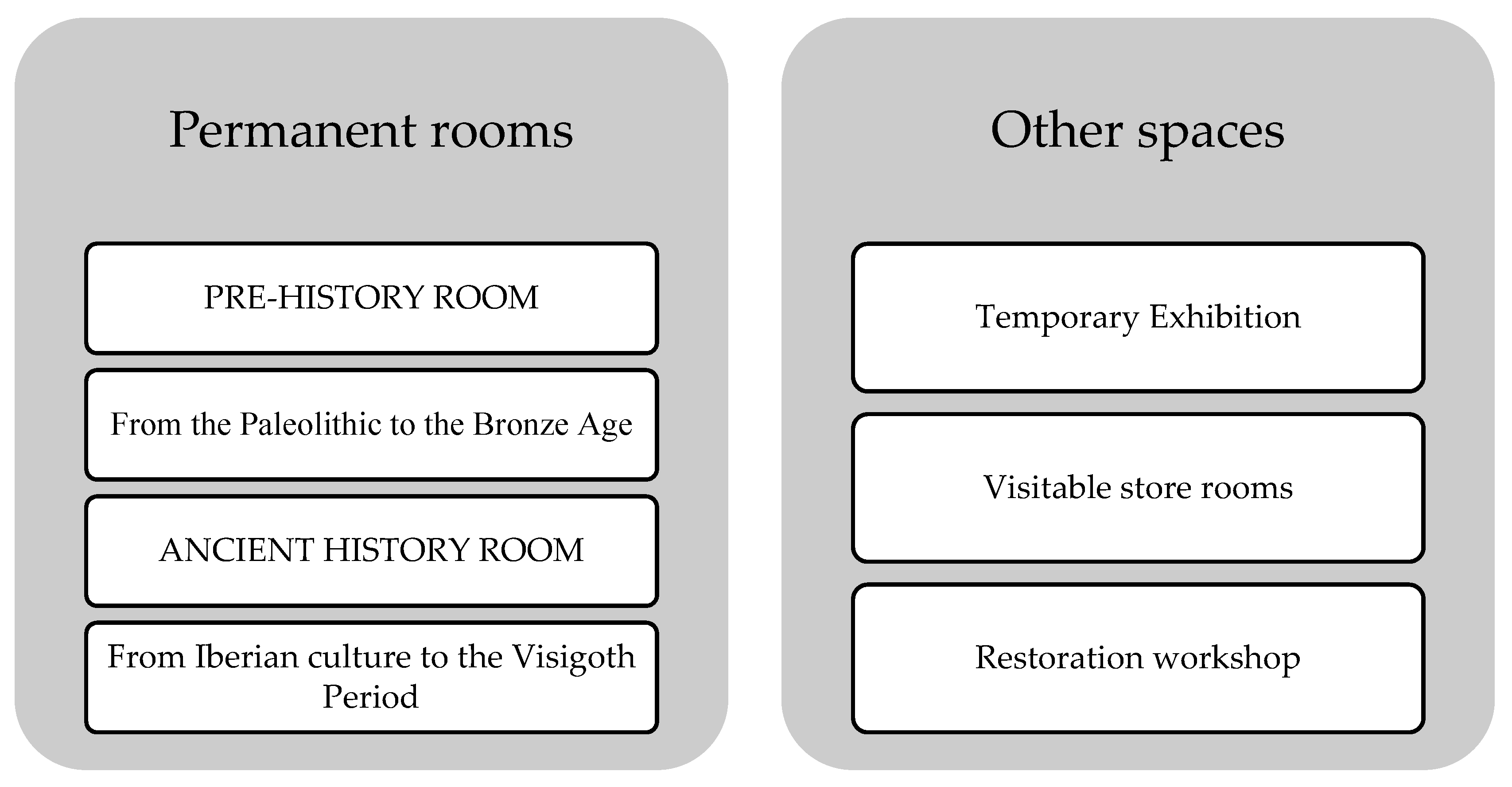
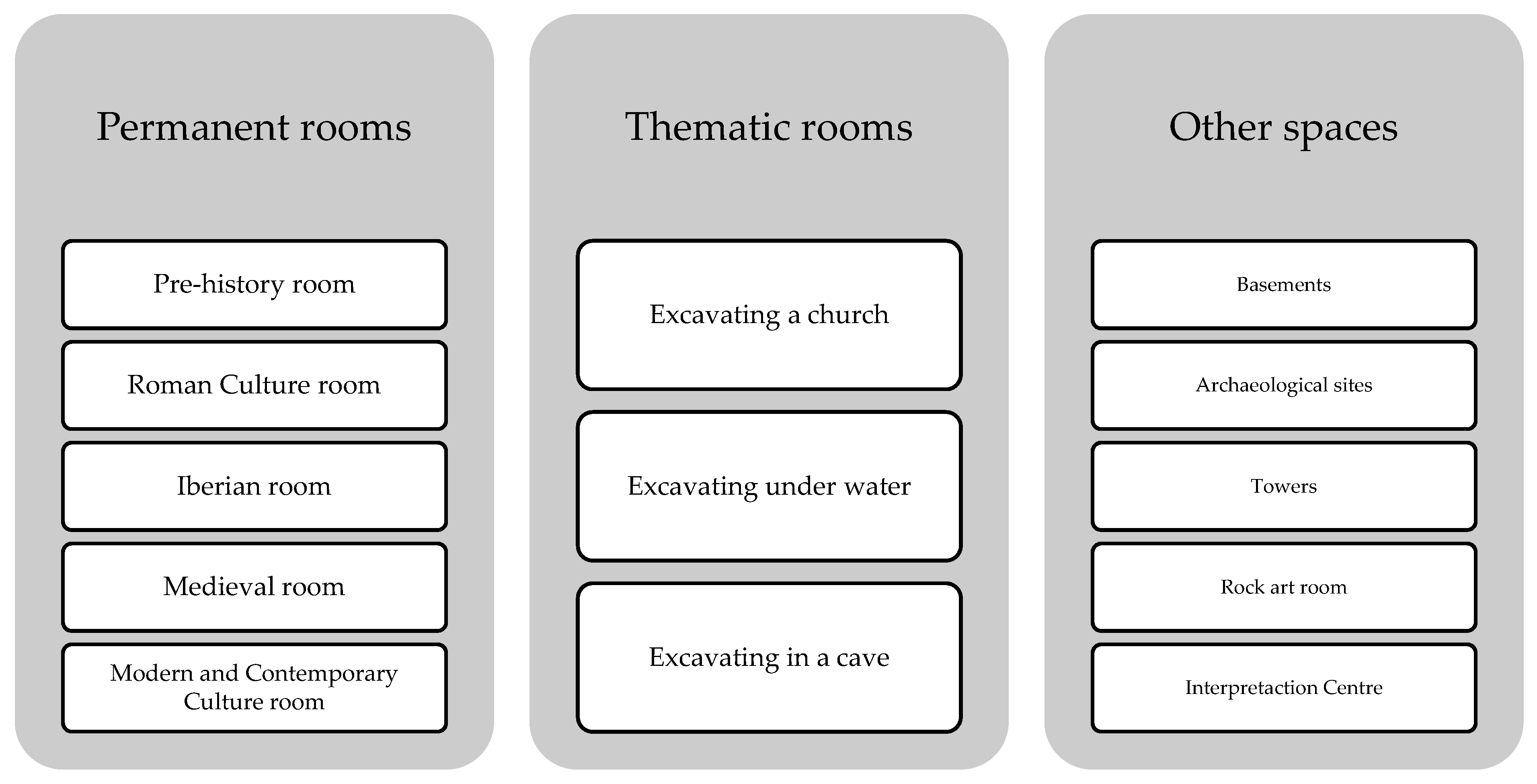

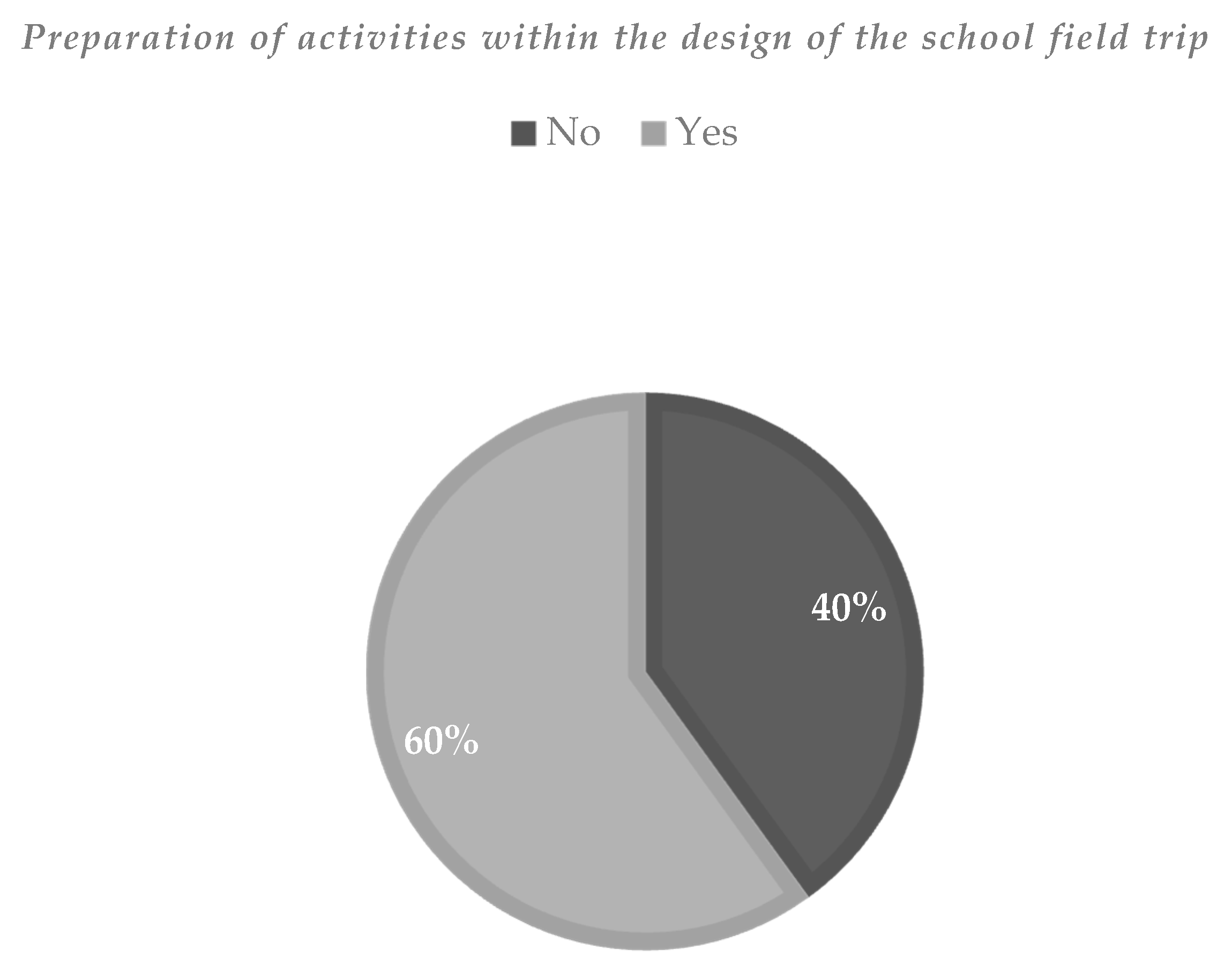
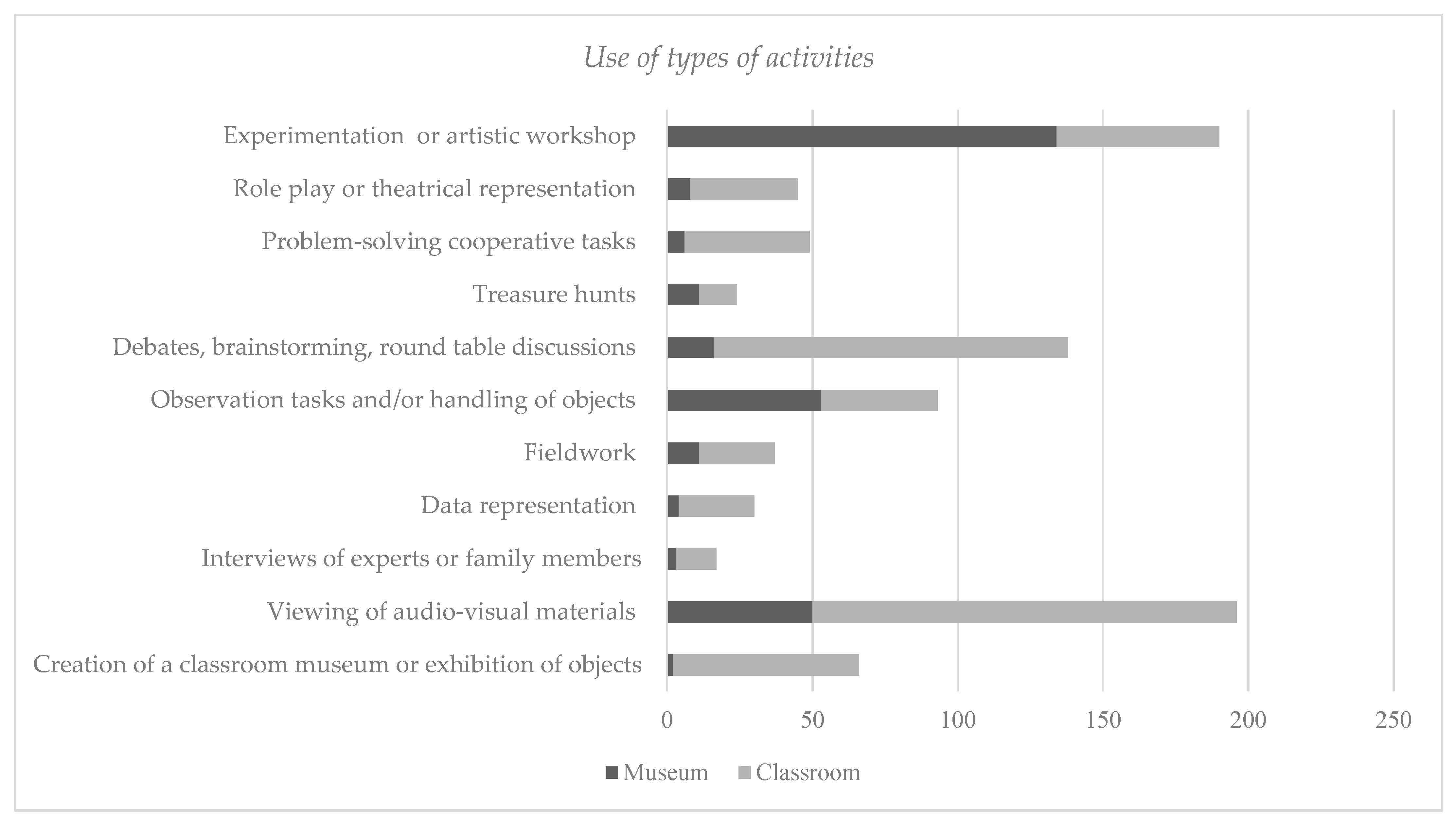
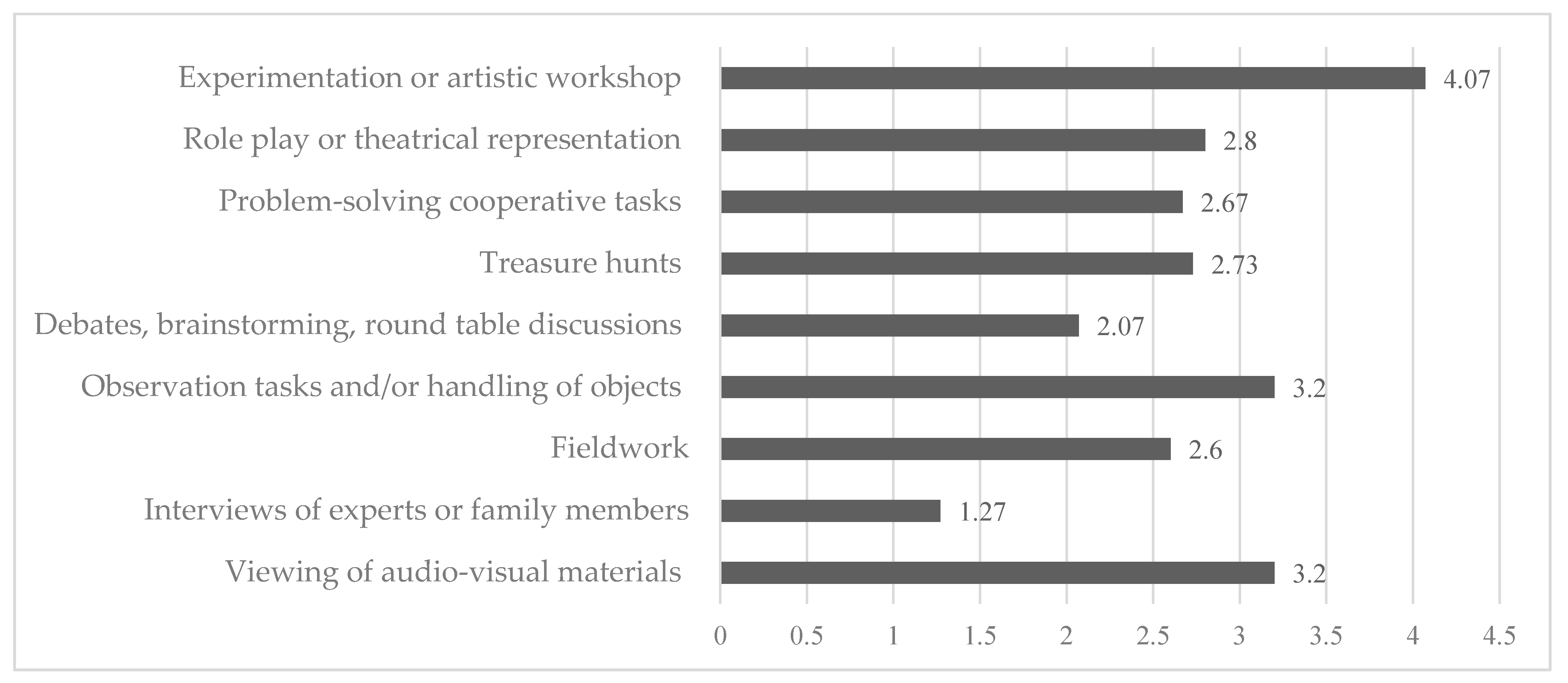
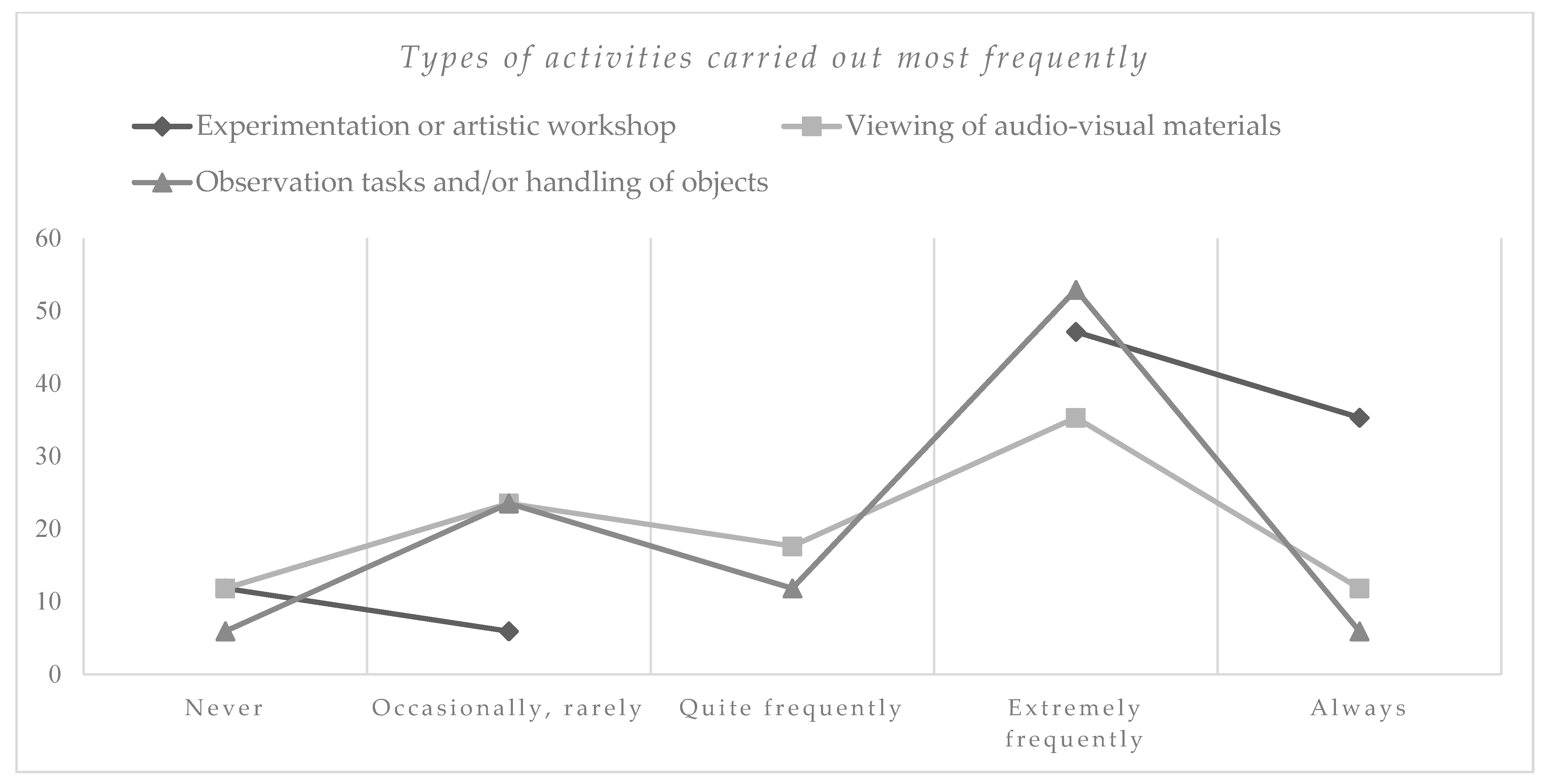
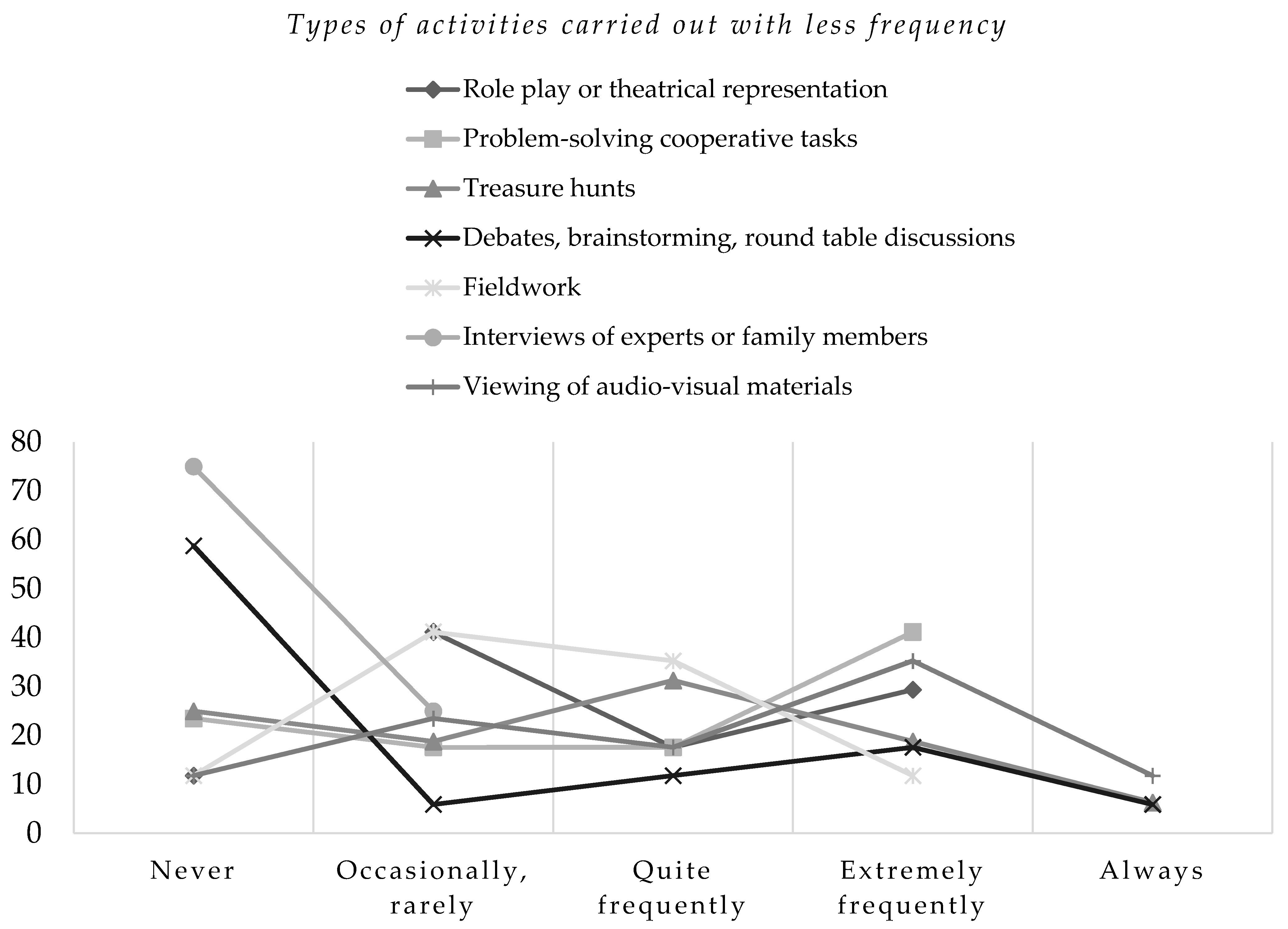

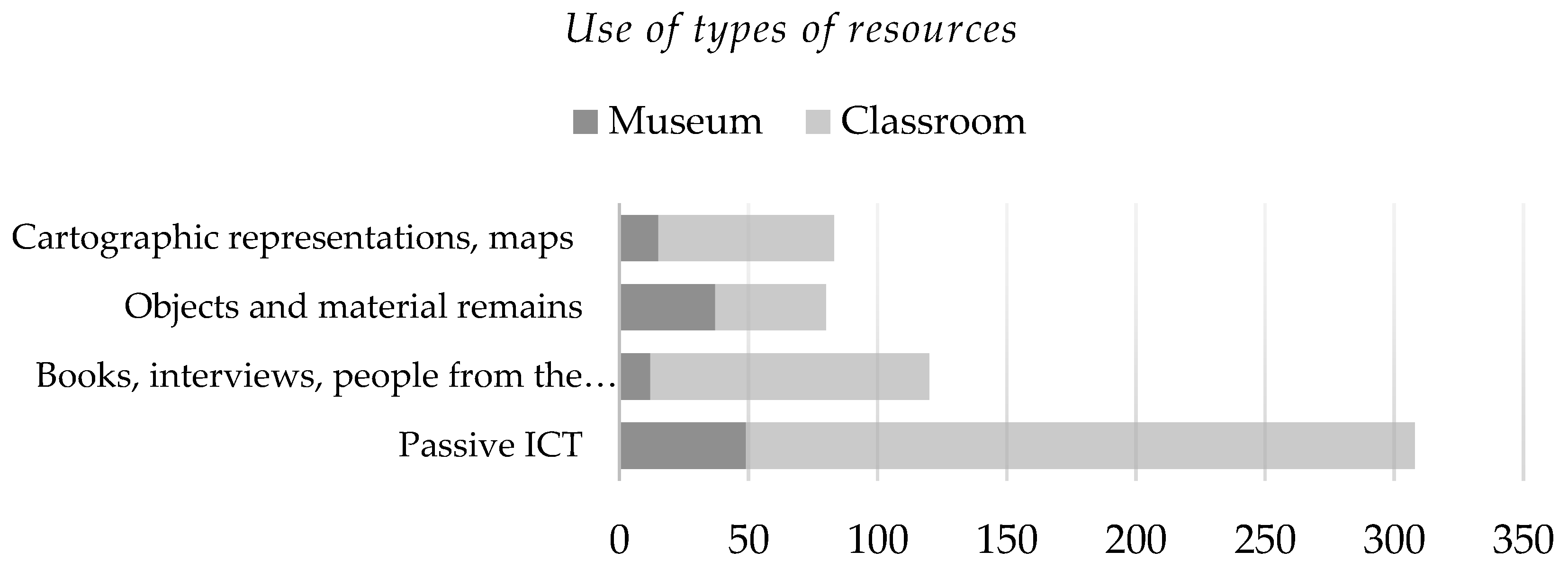
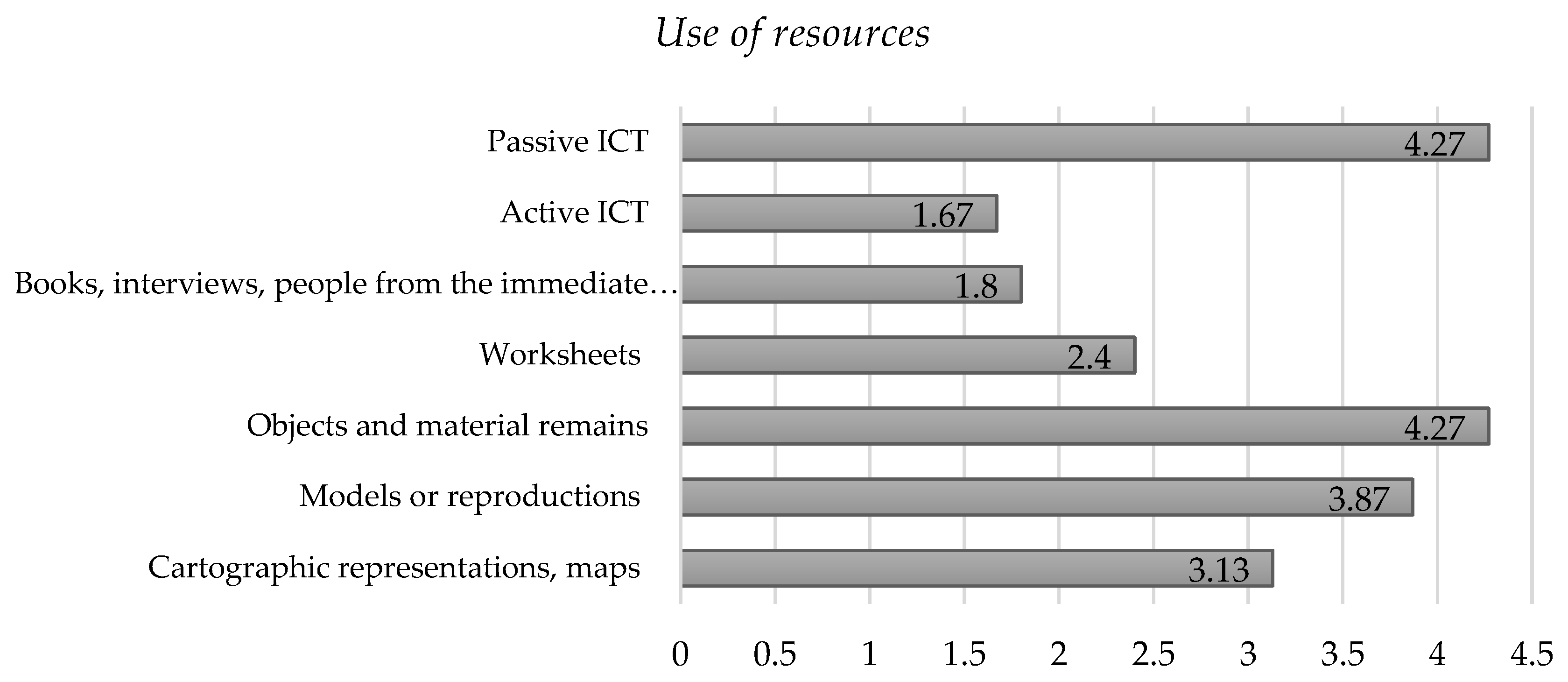
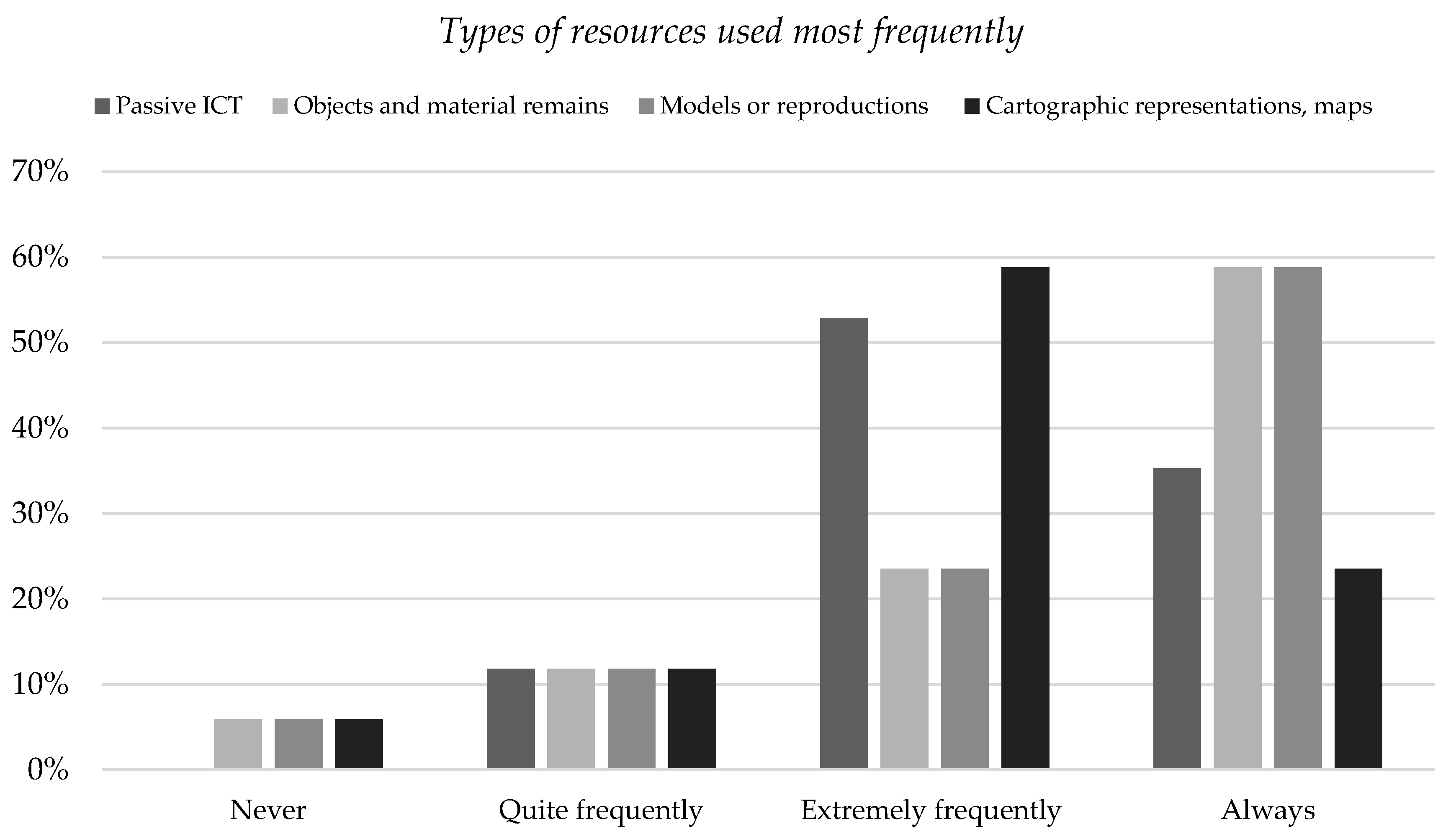
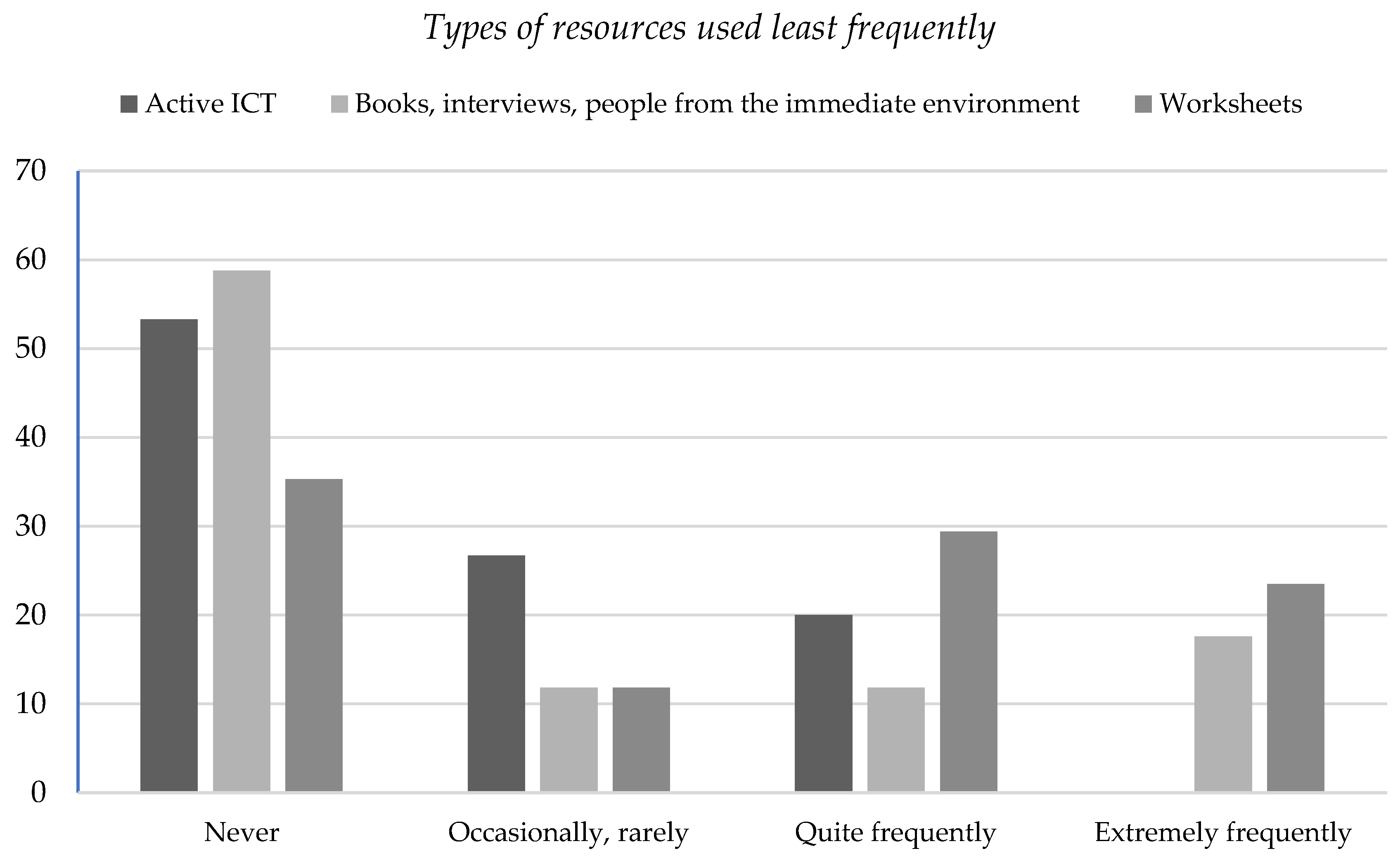
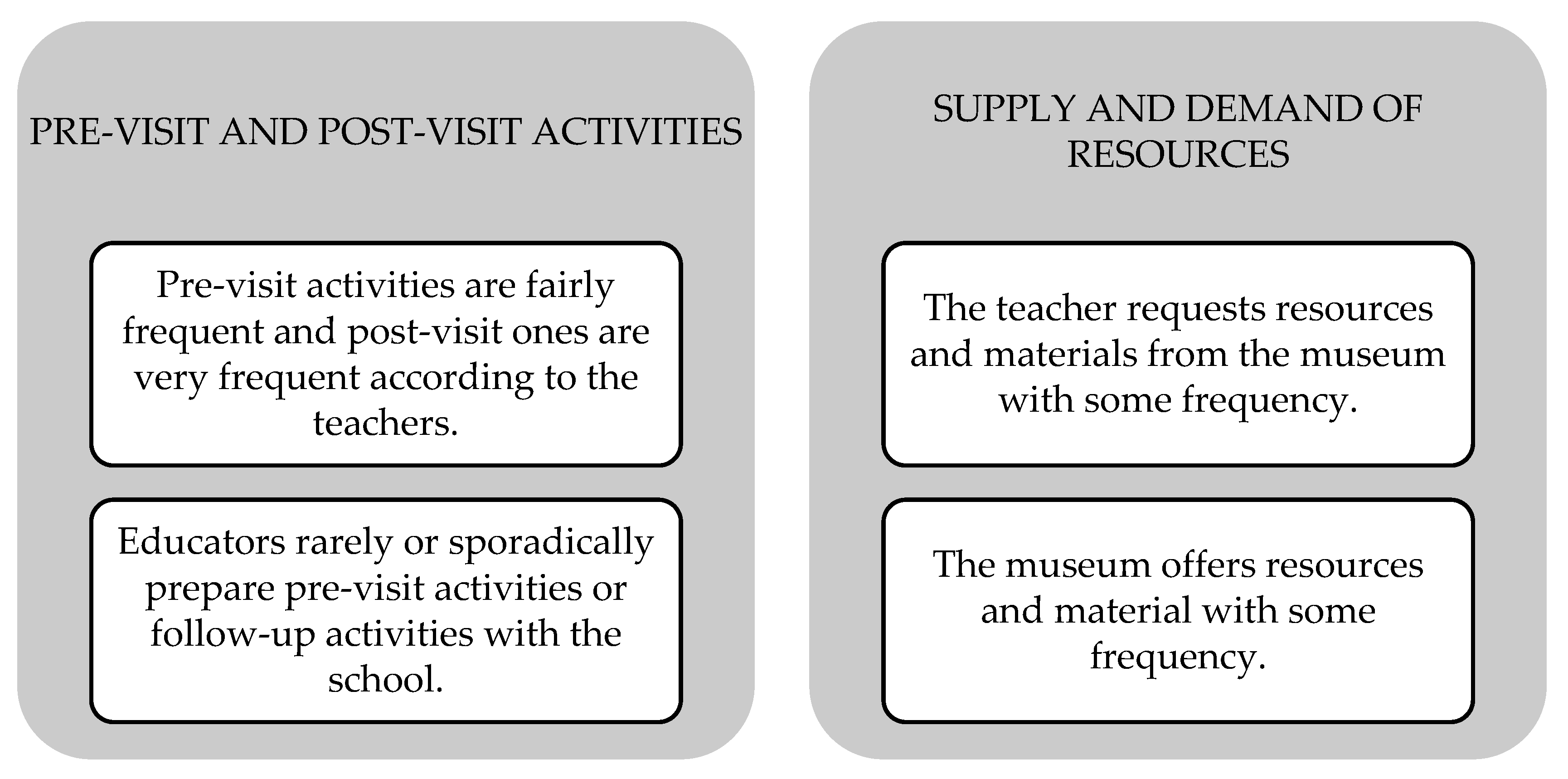
| The Classroom Museum for the Globalized Teaching of History in Early Years Education | |
|---|---|
| Educational approach | Classroom museum and museum for the classroom |
| Method | Project-based Learning |
| Teaching sequence | Phase 1 (initial): Motivation, queries, exchange of ideas and proposals Phase 2 (development): Obtaining new information (confrontation with new ideas) Phase 3 (synthesis): Structuring (Reflection and conclusions) Phase 4 (final): Using what has been learned |
| Organization of spaces | The classroom museum: work corners Assembly Purple room. Our grandparents house Red room. Exhibition of paintings Green room. The painter’s desk Blue room. The study of drawing and painting |
| Resources | Working with primary sources Cultural heritage Visit to the Ramón Gaya Museum |
| Planning for a Field Trip to an Archaeological Museum | ||
|---|---|---|
| Objectives | Independent Variable | Dependent Variable |
| Objective 1. To compare the activities which have been prepared in the design of the field trips from the perspective of teachers and museum educators. | Role of the educational agents The educational space | Type of activities |
| Objective 2. To describe the use of the resources and materials from the point of view of the educational agents. | Type of resources and materials | |
|
Educative Space Type of Activity | Museum | Classroom |
|---|---|---|
| Total Percent | ||
| Experimentation or artistic workshop | 31.4 | 13.1 |
| Role play or theatrical representation | 1.9 | 8.7 |
| Problem-solving cooperative tasks | 1.4 | 10.1 |
| Treasure hunts | 2.6 | 3 |
| Debates, brainstorming, round table discussions | 3.7 | 28.6 |
| Observation tasks and/or handling of objects | 12.4 | 9.4 |
| Fieldwork | 2.6 | 6.1 |
| Data representation | 0.9 | 6.1 |
| Interviews of experts or family members | 0.7 | 3.3 |
| Viewing of audio-visual materials | 11.7 | 34.2 |
| Creation of a classroom museum or exhibition of objects | 0.5 | 15 |
| Use | Classroom Space | |||
|---|---|---|---|---|
| No | Yes | Total | ||
| Museum space | No | 92.3% | 5.2% | 97.4% |
| Yes | 1.6% | 0.9% | 2.6% | |
| Total | 93.9% | 6.1% | 100.0% | |
| Use | Classroom Space | |||
|---|---|---|---|---|
| No | Yes | Total | ||
| Museum space | No | 59.7% | 28.6% | 88.3% |
| Yes | 6.1% | 5.6% | 11.7% | |
| Total | 65.8% | 34.2% | 100.0% | |
| Type of Activity | Educational Stage | Museum | Classroom | Before | During | After |
|---|---|---|---|---|---|---|
| Experimentation or artistic workshop | Early years | 10.3% | 6.6% | 5.6% | 9.6% | 4.2% |
| Primary education | 16.9% | 5.2% | 3% | 16% | 3.7% | |
| Secondary education | 4.2% | 1.4% | 0.7% | 4.2% | 0.7% | |
| Role Play or theatrical representation | Early years | 0.7% | 4.4% | 2.8% | 0.7% | 1.6% |
| Primary education | 0.7% | 3.3% | 2.3% | 0.7% | 0.9% | |
| Secondary education | 0.5% | 0.9% | 0.5% | 0.5% | 0.5% | |
| Problem-solving cooperative tasks | Early years | 0% | 2.8% | 2.6% | 0.5% | 0.7% |
| Primary education | 0.9% | 5.6% | 3.5% | 0.9% | 2.6% | |
| Secondary education | 0.5% | 1.6% | 1.2% | 0.5% | 0.7% | |
| Treasure hunts | Early years | 1.2% | 0.9% | 0.7% | 1.2% | 0.5% |
| Primary education | 1.2% | 1.9% | 1.2% | 0.9% | 0.9% | |
| Secondary education | 0.2% | 0.2% | 0% | 0.2% | 0.2% | |
| Debate, brainstorming, round table discussions | Early years | 1.6% | 6.3% | 4% | 1.9% | 4% |
| Primary education | 1.6% | 17.1% | 7.3% | 1.9% | 12% | |
| Secondary education | 0.5% | 5.2% | 2.1% | 0.7% | 4.7% | |
| Observation tasks and/or handling of objects | Early years | 4.2% | 3.5% | 2.8% | 4.2% | 1.4% |
| Primary education | 6.3% | 4.9% | 2.8% | 6.1% | 2.6% | |
| Secondary education | 1.9% | 0.9% | 0.9% | 1.9% | 0.2% | |
| Fieldwork | Early years | 0.7% | 1.2% | 1.2% | 0.5% | 0.5% |
| Primary education | 1.4% | 3.5% | 2.8% | 1.4% | 0.9% | |
| Secondary education | 0.5% | 1.4% | 0.7% | 0.5% | 0.9% | |
| Data representation | Early years | 0.2% | 2.1% | 1.2% | 0.2% | 1.2% |
| Primary education | 0.7% | 2.3% | 1.9% | 0.7% | 0.7% | |
| Secondary education | 0% | 1.6% | 0.5% | 0% | 1.2% | |
| Interviews of experts or family members | Early years | 0% | 1.4% | 1.2% | 0% | 0.2% |
| Primary education | 0.7% | 1.2% | 1.2% | 0.5% | 0.5% | |
| Secondary education | 0% | 0.7% | 0.7% | 0% | 0.5% | |
| Viewing of audio-visual materials | Early years | 3.7% | 8.2% | 7.3% | 4.2% | 3.3% |
| Primary education | 7.3% | 20.4% | 17.8% | 7.7% | 7% | |
| Secondary education | 0.7% | 5.6% | 4.9% | 0.7% | 2.8% | |
| Creation of a classroom museums or exhibition of objects | Early years | 0% | 6.1% | 3.5% | 0.5% | 2.6% |
| Primary education | 0.5% | 6.6% | 3.5% | 0.9% | 3.7% | |
| Secondary education | 0% | 2.3% | 0.7% | 0% | 1.9% |
| Educational Stage | Early Years | Primary Education | ||||||||
|---|---|---|---|---|---|---|---|---|---|---|
| Type of Activity | Museum | Classroom | Before | During | After | Museum | Classroom | Before | During | After |
| Experimentation or artistic workshop | X | X | X | X | ||||||
| Role Play or theatrical representation | X | X | ||||||||
| Viewing of audio-visual materials | X | X | ||||||||
| Creation of a classroom museums or exhibition of objects | X | X | ||||||||
|
Educative Space Type of Activity | Museum | Classroom |
|---|---|---|
| Total Percent | ||
| Passive ICT | 11.5 | 60.7 |
| Active ICT | 1.9 | 10.1 |
| Books, interviews, people from the immediate environment | 2.8 | 25.3 |
| Worksheets | 4.7 | 45.9 |
| Objects and material remains | 8.7 | 10.1 |
| Models or reproductions | 6.8 | 7 |
| Cartographic representations, maps | 3.5 | 15.9 |
| Use | Classroom | |||
|---|---|---|---|---|
| No | Yes | Total | ||
| Museum | No | 89% | 9.1% | 98.1% |
| Yes | 0.9% | 0.9% | 1.9% | |
| Total | 89.9% | 10.1% | 100.0% | |
| Use | Classroom | |||
|---|---|---|---|---|
| No | Yes | Total | ||
| Museum | No | 82.2% | 14.3% | 96.5% |
| Yes | 1.9% | 1.6% | 3.5% | |
| Total | 84.1% | 15.9% | 100.0% | |
| Type of Resources | Educational Stage | Museum | Classroom | Before | During | After |
|---|---|---|---|---|---|---|
| Web pages, audio-visual materials, photographs | Early years | 3% | 14.8% | 7.7% | 4% | 8.5% |
| Primary education | 6.6% | 34.7% | 20.9% | 5.9% | 23.9% | |
| Secondary education | 1.9% | 11.2% | 8.7% | 1.4% | 7.3% | |
| Video games, apps, QR codes, augmented reality, virtual museum | Early years | 0.5% | 3% | 0.9% | 0.2% | 2.3% |
| Primary education | 1.2% | 5.6% | 1.9% | 1.4% | 3.3% | |
| Secondary education | 0.2% | 1.4% | 1.4% | 0.2% | 0.7% | |
| Books, interviews, people from the immediate environment, etc. | Early years | 0.9% | 9.1% | 6.3% | 1.6% | 5.6% |
| Primary education | 1.9% | 11.7% | 6.1% | 2.6% | 7.5% | |
| Secondary education | 0% | 4.4% | 3.3% | 0% | 2.8% | |
| Worksheets | Early years | 2.1% | 15.7% | 8.2% | 2.3% | 12.2% |
| Primary education | 1.6% | 22% | 9.4% | 3% | 17.6% | |
| Secondary education | 0.9% | 8.2% | 4.4% | 0.7% | 5.4% | |
| Objects and material remains | Early years | 2.1% | 6.1% | 4.4% | 2.1% | 4.7% |
| Primary education | 4.9% | 3% | 2.1% | 4.4% | 2.1% | |
| Secondary education | 1.6% | 0.9% | 1.4% | 1.2% | 0.5% | |
| Models or reproductions | Early years | 1.6% | 2.6% | 1.4% | 1.4% | 2.1% |
| Primary education | 4.4% | 3.3% | 1.9% | 4.2% | 1.6% | |
| Secondary education | 0.7% | 1.2% | 0.9% | 0.7% | 0.7% | |
| Cartographic representations, maps | Early years | 0.7% | 2.6% | 0.9% | 0.7% | 2.1% |
| Primary education | 2.1% | 7.7% | 3.7% | 2.3% | 5.4% | |
| Secondary education | 0.7% | 5.6% | 4.2% | 0.5% | 3.5% |
| Educational Stage | Early Years | Primary Education | ||||||||
|---|---|---|---|---|---|---|---|---|---|---|
| Type of Resources | Museum | Classroom | Before | During | After | Museum | Classroom | Before | During | After |
| Web pages, audio-visual materials, photographs | X | X | X | |||||||
| Books, interviews, people from the immediate environment, etc. | X | |||||||||
| Worksheets | X | X | ||||||||
| Objects and material remains | X | X | X | |||||||
| Cartographic representations, maps | X | X | ||||||||
Publisher’s Note: MDPI stays neutral with regard to jurisdictional claims in published maps and institutional affiliations. |
© 2021 by the authors. Licensee MDPI, Basel, Switzerland. This article is an open access article distributed under the terms and conditions of the Creative Commons Attribution (CC BY) license (https://creativecommons.org/licenses/by/4.0/).
Share and Cite
Escribano-Miralles, A.; Serrano-Pastor, F.-J.; Miralles-Martínez, P. The Use of Activities and Resources in Archaeological Museums for the Teaching of History in Formal Education. Sustainability 2021, 13, 4095. https://doi.org/10.3390/su13084095
Escribano-Miralles A, Serrano-Pastor F-J, Miralles-Martínez P. The Use of Activities and Resources in Archaeological Museums for the Teaching of History in Formal Education. Sustainability. 2021; 13(8):4095. https://doi.org/10.3390/su13084095
Chicago/Turabian StyleEscribano-Miralles, Ainoa, Francisca-José Serrano-Pastor, and Pedro Miralles-Martínez. 2021. "The Use of Activities and Resources in Archaeological Museums for the Teaching of History in Formal Education" Sustainability 13, no. 8: 4095. https://doi.org/10.3390/su13084095
APA StyleEscribano-Miralles, A., Serrano-Pastor, F.-J., & Miralles-Martínez, P. (2021). The Use of Activities and Resources in Archaeological Museums for the Teaching of History in Formal Education. Sustainability, 13(8), 4095. https://doi.org/10.3390/su13084095






